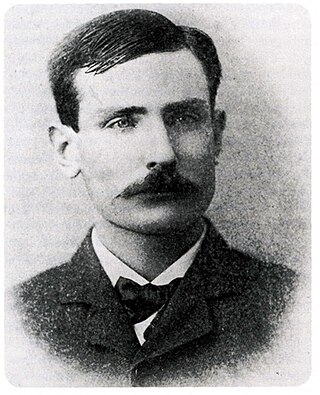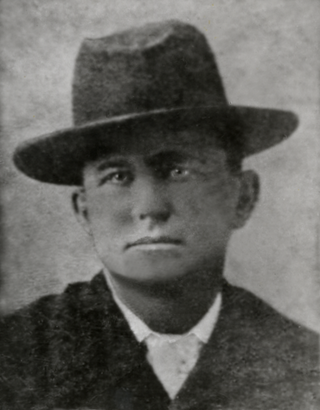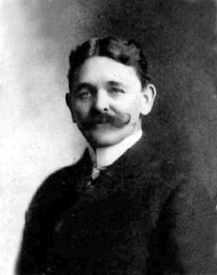
The Dalton Gang was a group of outlaws in the American Old West during 1890–1892. It was also known as The Dalton Brothers because four of its members were brothers. The gang specialized in bank and train robberies. During an attempted double bank robbery in Coffeyville, Kansas in 1892, two of the brothers and two other gang members were killed; Emmett Dalton survived, was captured, and later pleaded guilty to second-degree murder, although he later asserted that he never fired a shot during the robbery. He was paroled after serving 14 years in prison.

The Wild Bunch, also known as the Doolin–Dalton Gang, or the Oklahombres, were a gang of American outlaws based in the Indian Territory in the late 19th and early 20th centuries. They were active in Kansas, Missouri, Arkansas, and Oklahoma Territory during the 1890s—robbing banks and stores, holding up trains, and killing lawmen. They were also known as The Oklahoma Long Riders because of the long dusters that they wore.

William Doolin was an American bandit outlaw and founder of the Wild Bunch, sometimes known as the Doolin-Dalton Gang. Like the earlier Dalton Gang alone, it specialized in robbing banks, trains, and stagecoaches in Arkansas, Kansas, Indiana, and Oklahoma during the 1890s.

William Matthew Tilghman Jr. was a career lawman, gunfighter, and politician in Kansas and Oklahoma during the late 19th century. Tilghman was a Dodge City city marshal in the early 1880s and played a role in the Kansas County Seat Wars. In 1889 he moved to Oklahoma where he acquired several properties during a series of land rushes. While serving as a Deputy U.S. Marshal in Oklahoma, he gained recognition for capturing the notorious outlaw Bill Doolin and helping to track and kill the other members of Doolin's gang, which made him famous as one of Oklahoma's "Three Guardsmen".
Chris Madsen was a lawman of the Old West who is best known as being one of The Three Guardsmen, the name given to Madsen and two other Deputy US Marshals who were responsible for the apprehension and/or killing of several outlaws of that era. The Three Guardsmen consisted of Madsen, Bill Tilghman, and Heck Thomas.
The Three Guardsmen is the name popularized in Old West literature describing three lawmen who became legendary in their pursuit of many outlaws of the late 19th century. Deputy U.S. Marshals Bill Tilghman (1854–1924), Chris Madsen (1851–1944), and Heck Thomas (1850–1912) were "The Three Guardsmen", working under U.S. Marshal Evett "E.D." Nix.

Henry Andrew "Heck" Thomas was a lawman on the American frontier, most notably in Indian Territory. He was known for helping bring law and order to the region. In 1889 as a deputy in Fort Smith, Arkansas, he tried to capture Ned Christie (Cherokee), wanted as a suspect in the killing of a US marshal.

James Patrick Masterson, was a lawman of the American West and a younger brother of gunfighters and lawmen Bat Masterson and Ed Masterson.

George "Bitter Creek" Newcomb was an American outlaw of the American Old West. He was first a member of the Dalton Gang, but after being called "too wild" by Bob Dalton, he and Bill Doolin started the Wild Bunch gang.
Richard "Little Dick" West was an American outlaw of the Old West, and a member of Bill Doolin's gang.

William "Tulsa Jack" Blake was an American outlaw of the Old West, and member of the Wild Bunch gang. He had been a cowboy in Kansas through the 1880s, before drifting into Oklahoma Territory, where in 1892 he met outlaw Bill Doolin, and joined Doolin's Wild Bunch gang, sometimes called the Oklahombres, or the Doolin-Dalton Gang.

Roy Daugherty, also known as Arkansas Tom Jones, was an American outlaw of the Old West, and a member of the Wild Bunch gang, led by Bill Doolin. He was the longest-lived, as well as the last surviving member of the gang.

Mason Frakes Dalton, also known as William Marion "Bill" Dalton, was an outlaw in the American Old West. He was the co-leader of the Wild Bunch gang and with his brothers Gratton, Bob and Emmett Dalton was a member of the Dalton Gang.
The Battle of Ingalls was a gunfight on September 1, 1893 between United States Marshals and the Doolin-Dalton Gang, during the closing years of the Old West era, in Ingalls, Oklahoma. The Doolin-Dalton Gang had been involved in a number of train robberies and bank robberies, beginning around 1891. They had found a safe haven in the town of Ingalls, which unwittingly harbored many outlaws during that period. On September 1, 1893, a posse was organized by the new United States Marshal, Evett Dumas "E.D." Nix, which entered the outlaw town of Ingalls with the intent to capture the gang. The lawmen were engaged in a gunbattle in which three of the fourteen lawmen carrying Deputy Marshals' commissions would die as a result of the battle.

Charley Pierce was an American outlaw in the American Old West who rode with both the Dalton Gang and the Doolin Dalton Gang during the 1890s. He and "Bittercreek" Newcomb were killed by friends, the Dunn brothers, for bounty money.
Oliver Yantis, known as Oliver "Ol" Yantis was an American outlaw of the Old West, best known for being a member of the Doolin Dalton Gang.
Wiley Ulysses Lynn was an American prohibition agent during the early 20th century, best known for having killed legendary lawman Bill Tilghman, on November 1, 1924, in Cromwell, Oklahoma.

Robert Rennick Dalton was an American outlaw in the American Old West. Beginning in 1891, he led the Dalton Gang, whose varying members included three of his brothers. They were known for robbing banks, stagecoaches and trains, primarily in Kansas and Oklahoma Territory, quickly attracting pursuit by lawmen.

The Blackwell gunfight occurred on the morning of December 4, 1896, when a posse of American lawmen confronted two bandits at their hideout near Blackwell, Oklahoma. During a lengthy shootout that followed, Deputy Alfred O. Lund killed an outlaw named Dick Ainsley while the other outlaw, Ben Cravens, was badly wounded and captured.
Little Britches is an outlaw in the American Old West associated with Cattle Annie. Their exploits are fictionalized in the 1981 film Cattle Annie and Little Britches, directed by Lamont Johnson and starring Diane Lane as Little Britches.











